RECOMMENDED
Kentwood Players takes on the many challenges of Ragtime, one of the most truly epic shows ever to have filled a Broadway stage, and achieves laudable results for a community theater production.
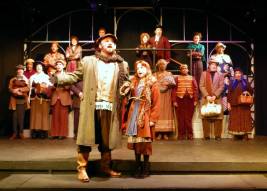 Based on E. L. Doctorow’s 1975 novel, Ragtime The Musical (book by Terrence McNally, music by Stephen Flaherty and lyrics by Lynn Ahrens) takes us back a century to a time of historic change in the United States, a time when the country was divided between The Haves (the super-rich like Henry Ford and J.P. Morgan, both of whom are supporting characters in Ragtime) and The Have-Nots (African-Americans and European immigrants).
Based on E. L. Doctorow’s 1975 novel, Ragtime The Musical (book by Terrence McNally, music by Stephen Flaherty and lyrics by Lynn Ahrens) takes us back a century to a time of historic change in the United States, a time when the country was divided between The Haves (the super-rich like Henry Ford and J.P. Morgan, both of whom are supporting characters in Ragtime) and The Have-Nots (African-Americans and European immigrants).
Though the haves wanted to believe, as they sing in Ragtime’s opening number, that “there were no Negroes and there were no immigrants,” people like Ragtime’s fictional “Father,” “Mother,” “Younger Brother,” and “Little Boy” were soon to find out otherwise.
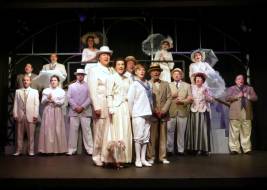 Mother (Jennifer Sperry) takes in an African-American baby found in her garden, and later the child’s unwed mother Sarah (Johanna Rose Burwell). Younger brother (Slater Ross) becomes inspired by anarchist Emma Goldman (Joanna Churgin), and not long after joins Sarah’s lover, musician Coalhouse Walker, Jr. (Deus Xavier Scott), in the forced takeover of the Morgan Library. And Mother’s life eventually becomes intertwined with those of immigrant Tateh (Bradley Miller) and his young daughter (Karen E. Kolkey).
Mother (Jennifer Sperry) takes in an African-American baby found in her garden, and later the child’s unwed mother Sarah (Johanna Rose Burwell). Younger brother (Slater Ross) becomes inspired by anarchist Emma Goldman (Joanna Churgin), and not long after joins Sarah’s lover, musician Coalhouse Walker, Jr. (Deus Xavier Scott), in the forced takeover of the Morgan Library. And Mother’s life eventually becomes intertwined with those of immigrant Tateh (Bradley Miller) and his young daughter (Karen E. Kolkey).
The original Broadway production featured a cast of fifty. Kentwood Players cuts this down to forty-three, still a huge number for any production, and a particularly daunting one for a community theater which draws many of its cast members from “regular folks” who happen to love performing in their spare time.
Ensemble members Greg Abbott, Jeannine Barba, Heather Barnett, Erika Brauer, Jacquelyn Carr, Jim Crawford, Sheridan Cole Crawford, Jacqueline Crist-Franzen, Terry Delegeane, Ruth Andrea Featherstone, Martin Feldman, Jackie Fiske, Shamika Franklin, Samuel Goldman, Justin P. James, Spencer Johnson, J. Paul Myers, Fiona Okida, Roy T. Okida, James Olivas, Michelle M. Pedersen, Judy Rosenfeld, Megan Ruble, Bruce Schroffel, Hollister Starrett, Christopher Stefanic, Jessica D. Stone, Courtney L. Williams, Ja’von Willis, and Marcus Alan Wynn join voices to powerful effect in the rousing opening number, the stirring “Till We Reach That Day,” and the grand finale reprise of “Wheels Of Your Dream,” credit for their gorgeous harmonies shared with musical director Bill Wolfe.
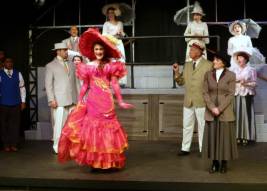 Ragtime manages to be at once epic, in both its power ballads and cast of well-known historical figures—Henry Ford (Abbott), Harry Houdini (Drew Fitzsimmons), J.P. Morgan (Feldman), Evelyn Nesbitt (Amanda Majkrzak), Admiral Perry (Schroffel), and Booker T. Washington (Darryl Maximilian Robinson), and personal, in its focus on a pair of families whose members also include Father (Rocky Miller), Grandfather (George Kondreck), and Little Boy (Logan Gould), and its focus on Coalhouse’s efforts to win Sarah back, on Tateh and his daughter’s first steps towards becoming Americans, and on Mother’s growing disillusionment in her marriage.
Ragtime manages to be at once epic, in both its power ballads and cast of well-known historical figures—Henry Ford (Abbott), Harry Houdini (Drew Fitzsimmons), J.P. Morgan (Feldman), Evelyn Nesbitt (Amanda Majkrzak), Admiral Perry (Schroffel), and Booker T. Washington (Darryl Maximilian Robinson), and personal, in its focus on a pair of families whose members also include Father (Rocky Miller), Grandfather (George Kondreck), and Little Boy (Logan Gould), and its focus on Coalhouse’s efforts to win Sarah back, on Tateh and his daughter’s first steps towards becoming Americans, and on Mother’s growing disillusionment in her marriage.
A pair of performances in particular stand out among the crowd. Sperry plays mother with strength and grace and sings in a rich, expressive soprano, while the powerfully-voiced [Bradley] Miller makes Tateh the epitome of paternal devotion and the dauntless American immigrant spirit.
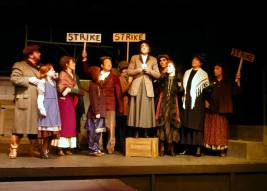 Churgin’s feisty Emma Goldman, Fitzsimmons charismatic Houdini, Gould’s spunky Little Boy, Kolkey’s sweet-faced Little Girl, Majkrzak’s oomphy Evelyn Nesbitt, Robinson’s towering Booker T. Washington, and Ross’s impetuous Younger Brother are standouts as well, while Featherstone’s solo in “Till We Reach That Day” reaches epic gospel proportions.
Churgin’s feisty Emma Goldman, Fitzsimmons charismatic Houdini, Gould’s spunky Little Boy, Kolkey’s sweet-faced Little Girl, Majkrzak’s oomphy Evelyn Nesbitt, Robinson’s towering Booker T. Washington, and Ross’s impetuous Younger Brother are standouts as well, while Featherstone’s solo in “Till We Reach That Day” reaches epic gospel proportions.
Less successful, though not without their merits, are Burwell’s Sarah and Scott’s Coalhouse. Burwell embodies Sarah’s sweetness and vulnerability, and gives “Your Daddy’s Son” a bit of a pop sound, which I enjoyed, but the role requires bigger, more operatic pipes to give that song and her duets with Coalhouse their full effectiveness. Scott acts the role of Coalhouse with dignity and power, is Armani-model handsome, and has a resonant speaking voice, but too often resorts to speak-singing, perhaps in an effort to avoid hitting the wrong notes, something which unfortunately happens on more than one occasion.
On a more positive note are Majkrzak’s sassy “Crime Of The Century” (wheeee!), the exquisite “New Music,” [Bradley] Miller and Kolkey’s jaunty “Buffalo Nickel Photoplay Inc.” and Miller’s lilting “Gliding,” the touching “Our Children” (an exquisite Miller-Sperry duet), and Sperry’s stirring “Back To Before.” The always wonderful Churgin makes her mark in two of the evening’s most moving numbers, “The Night That Goldman Spoke At Union Square” and “He Wanted To Say.” In a lighter vein, the baseball-inspired “What A Game” provides welcome comic relief in an increasingly dark Act Two.
Director Susan Goldman Weisbarth merits kudos for the simple fact of managing a production of this size and for guiding some very fine leading players. I wish, however, that she had worked more with those ensemble members cast in minor roles, many of whom could have benefited from some extra one-on-one attention, the better to say their few lines with greater authenticity and conviction. I wish also that Weisbarth had found more visually imaginative ways of blocking Ragtime’s huge cast than having them frequently spread across the stage in a long upstage row. Also, having the production’s African-American cast members double as immigrants seems jarringly inaccurate for a time in which virtually all newcomers were European (and the focus of Ragtime’s history-based storylines).
Choreographer Victoria Miller works hard to get dance performances from the company’s more inexperienced members. This works best in the lively “Crime Of The Century” and “The Gettin’ Ready Rag,” considerably less well in the awkwardly performed “Henry Ford.”
Ragtime benefits from a generally fine behind-stage orchestra, best when keyboardists Wolfe (who also conducts) and Danny Gledhill are featured, though Coleen Okida (flute, piccolo, and violin), Jon Stehney (clarinet, oboe), Gabe Garnett (trumpet), and Patrick Okonski (percussion) deserve frequent snaps as well.
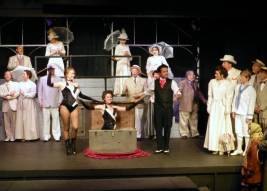 Jim Crawford’s simple but effective multi-level set design gives cast members more room to maneuver than you’d expect on the Westchester Playhouse stage, with kudos to an inventively designed Model T, player piano, and swing. John Beckwith’s lighting design has many effective moments as well. There’s also a bit of Houdini magic certain to delight. Best of all are Ragtime’s many finely rendered early 20th Century costumes, designed by Maria Cohen, Sheridan Cole Crawford, and Jayne Hamil.
Jim Crawford’s simple but effective multi-level set design gives cast members more room to maneuver than you’d expect on the Westchester Playhouse stage, with kudos to an inventively designed Model T, player piano, and swing. John Beckwith’s lighting design has many effective moments as well. There’s also a bit of Houdini magic certain to delight. Best of all are Ragtime’s many finely rendered early 20th Century costumes, designed by Maria Cohen, Sheridan Cole Crawford, and Jayne Hamil.
Ragtime is produced by Margie Bates and Gail Bernardi. Bruce Starrett is stage manager, no small task for a production of this magnitude.
Kentwood Players deserves highest marks simply for attempting the epic undertaking that is Ragtime and for delivering a number of first-rate performances and more than a few powerful moments. Despite its flaws, this is a production the 63-year-old Los Angeles amateur theater mainstay can feel proud to give its name to.
Kentwood Players, 8301 Hindry Ave., Westchester.
www.kentwoodplayers.org
–Steven Stanley
March 17, 2013
Photos: Shari Barrett


 Since 2007, Steven Stanley's StageSceneLA.com has spotlighted the best in Southern California theater via reviews, interviews, and its annual StageSceneLA Scenies.
Since 2007, Steven Stanley's StageSceneLA.com has spotlighted the best in Southern California theater via reviews, interviews, and its annual StageSceneLA Scenies.







 COPYRIGHT 2025 STEVEN STANLEY :: DESIGN BY
COPYRIGHT 2025 STEVEN STANLEY :: DESIGN BY